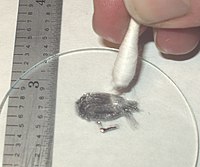
Photo from wikipedia
Lithium metal anodes (LMAs) have been suffering from challenging problems of solid electrolyte interface (SEI) formation and lithium morphological instability (LMI), which lead to a poor cycling life and notorious… Click to show full abstract
Lithium metal anodes (LMAs) have been suffering from challenging problems of solid electrolyte interface (SEI) formation and lithium morphological instability (LMI), which lead to a poor cycling life and notorious safety concerns. Herein, we prepared a 3D composite anode (Li@NFZO) by heat treatment and reactive wetting where nickel foam serves as the framework and LiZn/Li fills in the holes. Interestingly, it is found that such a nickel foam + LiZn combination can largely reinforce the electrode/electrolyte interface stability and thus slows down the electrolyte consumption. Furthermore, uniformly distributed and lithiophilic LiZn contributes to the homogenous Li plating so that dendrites can be geometrically disturbed. Therefore, stable cycling for 185 h at 5 mA h cm-2/5 mA cm-2 in symmetrical cells, 2.8× bare Li, was achieved. The cycling life of the LiFePO4//Li@NFZO full-cell at ≈6.6 g A h-1 electrolyte addition was prolonged to 120 cycles (80% capacity retention), compared to 66 cycles for the LiFePO4//Li full-cell.
Journal Title: Chemical communications
Year Published: 2020
Link to full text (if available)
Share on Social Media: Sign Up to like & get
recommendations!